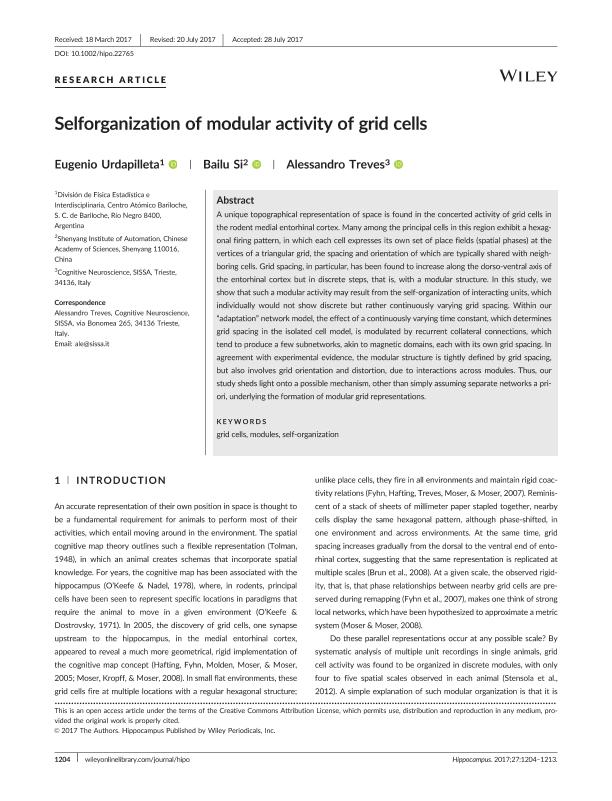Mostrar el registro sencillo del ítem
dc.contributor.author
Urdapilleta, Eugenio

dc.contributor.author
Si, Bailu

dc.contributor.author
Treves, Alessandro

dc.date.available
2019-02-18T19:07:17Z
dc.date.issued
2017-11
dc.identifier.citation
Urdapilleta, Eugenio; Si, Bailu; Treves, Alessandro; Selforganization of modular activity of grid cells; Wiley-liss, Div John Wiley & Sons Inc; Hippocampus; 27; 11; 11-2017; 1204-1213
dc.identifier.issn
1050-9631
dc.identifier.uri
http://hdl.handle.net/11336/70366
dc.description.abstract
A unique topographical representation of space is found in the concerted activity of grid cells in the rodent medial entorhinal cortex. Many among the principal cells in this region exhibit a hexagonal firing pattern, in which each cell expresses its own set of place fields (spatial phases) at the vertices of a triangular grid, the spacing and orientation of which are typically shared with neighboring cells. Grid spacing, in particular, has been found to increase along the dorso-ventral axis of the entorhinal cortex but in discrete steps, that is, with a modular structure. In this study, we show that such a modular activity may result from the self-organization of interacting units, which individually would not show discrete but rather continuously varying grid spacing. Within our “adaptation” network model, the effect of a continuously varying time constant, which determines grid spacing in the isolated cell model, is modulated by recurrent collateral connections, which tend to produce a few subnetworks, akin to magnetic domains, each with its own grid spacing. In agreement with experimental evidence, the modular structure is tightly defined by grid spacing, but also involves grid orientation and distortion, due to interactions across modules. Thus, our study sheds light onto a possible mechanism, other than simply assuming separate networks a priori, underlying the formation of modular grid representations.
dc.format
application/pdf
dc.language.iso
eng
dc.publisher
Wiley-liss, Div John Wiley & Sons Inc

dc.rights
info:eu-repo/semantics/openAccess
dc.rights.uri
https://creativecommons.org/licenses/by/2.5/ar/
dc.subject
Grid Cells
dc.subject
Modules
dc.subject
Self-Organization
dc.subject.classification
Astronomía

dc.subject.classification
Ciencias Físicas

dc.subject.classification
CIENCIAS NATURALES Y EXACTAS

dc.title
Selforganization of modular activity of grid cells
dc.type
info:eu-repo/semantics/article
dc.type
info:ar-repo/semantics/artículo
dc.type
info:eu-repo/semantics/publishedVersion
dc.date.updated
2019-02-12T14:31:47Z
dc.journal.volume
27
dc.journal.number
11
dc.journal.pagination
1204-1213
dc.journal.pais
Estados Unidos

dc.journal.ciudad
Nueva York
dc.description.fil
Fil: Urdapilleta, Eugenio. Consejo Nacional de Investigaciones Científicas y Técnicas. Centro Científico Tecnológico Conicet - Patagonia Norte; Argentina. Comisión Nacional de Energía Atómica. Centro Atómico Bariloche; Argentina
dc.description.fil
Fil: Si, Bailu. Chinese Academy of Sciences; República de China
dc.description.fil
Fil: Treves, Alessandro. Scuola Internazionale Superiore di Studi Avanzati; Italia
dc.journal.title
Hippocampus

dc.relation.alternativeid
info:eu-repo/semantics/altIdentifier/doi/http://dx.doi.org/10.1002/hipo.22765
dc.relation.alternativeid
info:eu-repo/semantics/altIdentifier/url/https://onlinelibrary.wiley.com/doi/full/10.1002/hipo.22765
Archivos asociados
